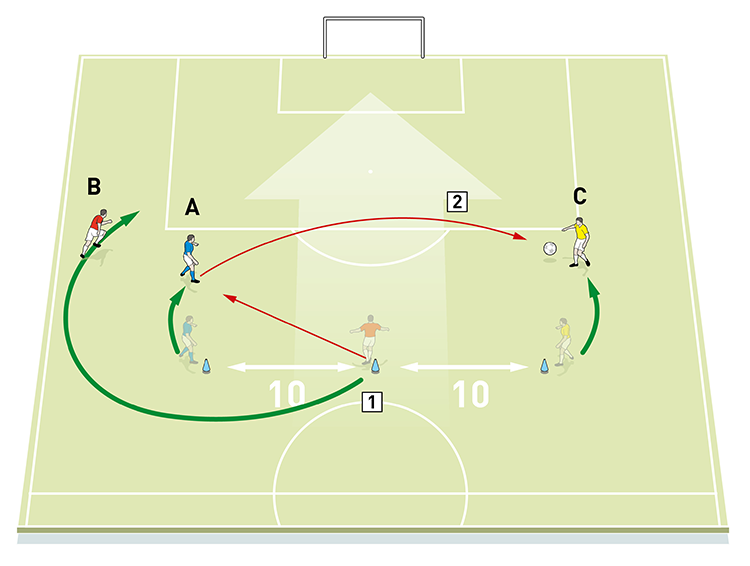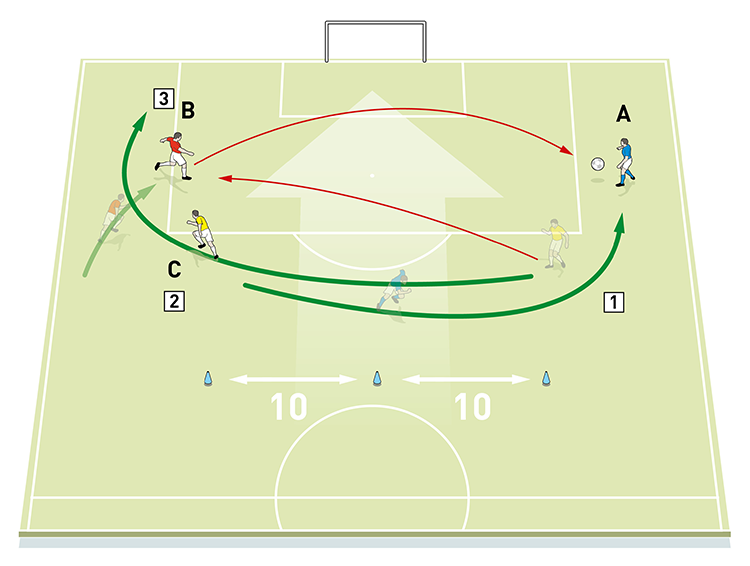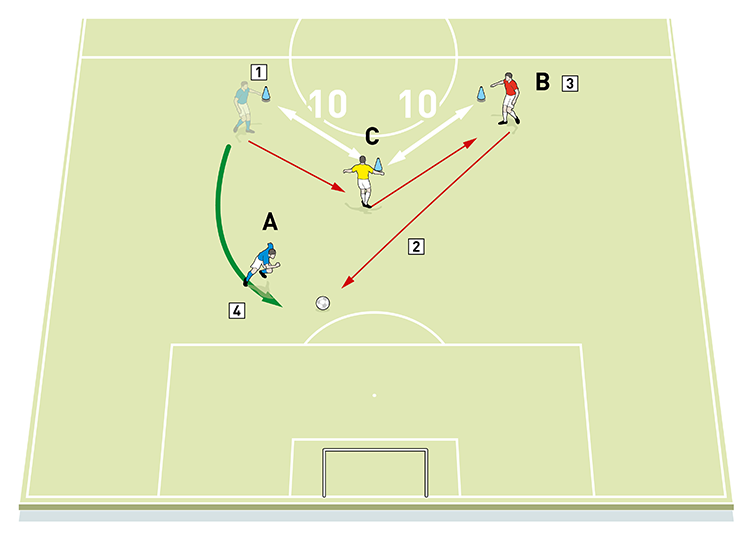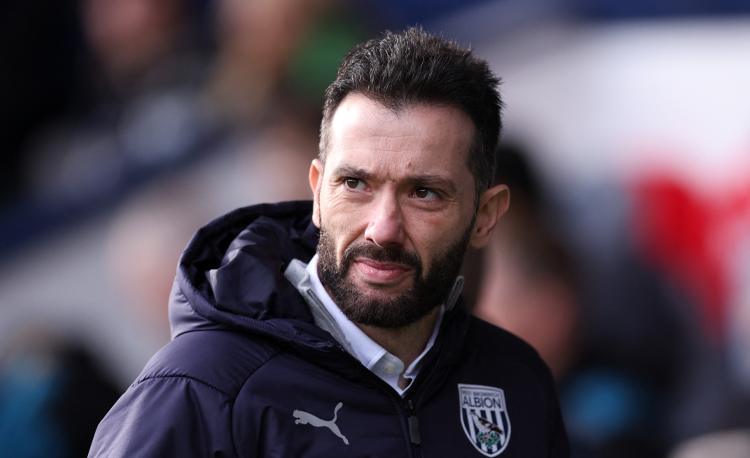You are viewing 1 of your 1 free articles
Technical passing with movement
| Area | Up to half a pitch |
| Equipment | Balls, bibs, cones |
| No. of Players | Groups of 3 players |
| Session Time | Introduction: 15mins, Introducing movement: 15mins, Third man runs 1: 20mins, Third man runs 2: 20mins, Small-sided game: 20mins |
This session is about encouraging players to receive the ball with the back foot and developing movement through deliberate practice.
These activities are both challenging and fun and they try to develop habits that will stay with players. It’s all about being comfortable receiving the ball with the left or right foot, using good body position and developing the right touch and feel. By adding movement to the exercises, we also start to concentrate young minds on the fact that the ‘picture’ changes as the ball and players move.
It’s very much a technical practice for the individual and for small groups. I would use it a couple of times a week and would certainly return to it on a regular basis, depending on the age and proficiency of the players.
What do I get the players to do?
Introduction
We set up with two players 10 yards apart. The ball starts with player A and both players run forward passing to each other as they are running, as shown [1]. We develop the practice by introducing one-touch play and passing with the outside foot; we switch the players regularly so they practise both left and right foot passing.
1

2. Players should be accurate and not have to break stride to receive
3. Start slowly and encourage the players to pick up the tempo as they feel confident
We start slowly and encourage the players to pick up the tempo as they feel confident. Players should be accurate and not have to break stride to receive.
Introducing movement
We set up with three players 10 yards apart. Player B (the middle player) starts with the ball and passes right footed to player A, then makes an overlapping run behind player A. Player A passes one touch with his left foot to Player C who is on the run, as shown [2a], and then player A overlaps player C. Player C passes right footed to player B, as shown [2b], and the sequence continues.
2a

2. Player A passes first time with his left foot to player C (yellow), who receives on the run
2b

2. Player C passes right footed to player B and then makes an overlapping run behind player B
3. Player B makes a left footed first-time pass to player A and the sequence continues
When players receive from the right, the key technical points we want to see is players letting the ball come across their body and using their left foot to pass; and when receiving from the left, players should use their right foot.
Introducing movement
Third man runs 1
We set up with three players in a triangle shape, with each player 10 yards away from the others. The players should be using the principles and techniques from the previous practices.
Player A starts with the ball and passes right footed to player C. Player C passes one touch right footed to player B, and player B passes left footed to player A who has made the third man run, as shown [3].
3

2. Yellow player C passes one touch right footed to red player B
3. Player B passes left footed to player A, who has made a third man run
4. To repeat, player A becomes the central player at the point of the triangle and B and C become the base of the triangle
To repeat, player A becomes the central player at the point of the triangle and B and C become the base of the triangle.
This practice must be one touch and performed with a good tempo.
Third man runs 2
Similar to the previous practice, we set up with three players in a triangle, with each player 10 yards away from the others. Players are limited to first-time passes.
Player A starts with the ball and passes right footed to player B
and makes an overlapping run around him. Player B passes left or right footed to player C and follows the pass. Player C passes left footed into player B’s run and B makes a pass to A at the end of his third man run, as shown [4]. Repeat as previously.
4

2. Red player B passes to yellow player C and follows the pass, receiving the ball back from C while on the run
3. Player B passes to A at the end of his overlapping run. Then repeat, as in previous practice
How would you put this in a game situation?
Small-sided game
We set up an area of 60x40 yards and play a 6v6 game [not shown], encouraging forward runs and first-time passing. We want to see players receiving the ball on their back foot, especially on their weaker side. Letting the ball come across their bodies should start to become the norm for players.
What are the key things to look out for?
We want to see players using a good body shape, receiving on the back foot and on the half turn. Players should also be comfortable with both feet and capable of passing and moving at high tempo.
We want to see good communication and players collaborating with their team mates, reading situations and understanding triggers for movement.
What are the typical mistakes players might make and how do I avoid them?
Players can pass and move too quickly, causing the practice to breakdown. To remedy this, we encourage players to perform the exercise at a slower pace until their confidence grows.
Another common mistake that we see is players making
inaccurate and erratic passes, especially using their weaker
side. To solve this problem, we get them to play with a slower tempo to encourage confidence on their weaker foot.
Related Files
Editor's Picks
Using the goalkeeper in build-up play
Pressing principles
Intensive boxes drill with goals
Penetrating the final third
Creating and finishing
My philosophy
Pressing initiation
Compact team movement
Defensive organisation
Coaches' Testimonials

Alan Pardew

Arsène Wenger

Brendan Rodgers

Carlos Carvalhal

José Mourinho

Jürgen Klopp

Pep Guardiola

Roy Hodgson

Sir Alex Ferguson

Steven Gerrard
Coaches' Testimonials

Gerald Kearney, Downtown Las Vegas Soccer Club

Paul Butler, Florida, USA

Rick Shields, Springboro, USA

Tony Green, Pierrefonds Titans, Quebec, Canada
Join the world's leading coaches and managers and discover for yourself one of the best kept secrets in coaching. No other training tool on the planet is written or read by the calibre of names you’ll find in Elite Soccer.
In a recent survey 92% of subscribers said Elite Soccer makes them more confident, 89% said it makes them a more effective coach and 91% said it makes them more inspired.
Get Monthly Inspiration
All the latest techniques and approaches
Since 2010 Elite Soccer has given subscribers exclusive insight into the training ground practices of the world’s best coaches. Published in partnership with the League Managers Association we have unparalleled access to the leading lights in the English leagues, as well as a host of international managers.
Elite Soccer exclusively features sessions written by the coaches themselves. There are no observed sessions and no sessions “in the style of”, just first-hand advice delivered direct to you from the coach.









